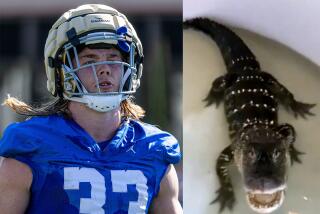Crocodile Skin Sales Boost Small Australian Tribe’s Economy : Trade: Handbags made from soft bellies can fetch $10,200. Now, the Pormpuraaw aboriginal people have jobs.
- Share via
TRINITY INLET, Australia — An Australian saltwater crocodile looks like evil itself floating just below the surface as its tiny, slitted eyes train on a shoreline prey.
But for the Pormpuraaw aboriginal people who own the Edward River Crocodile Farm on the western edge of Australia’s Cape York peninsula, the crocodile, or minpich, is a meal ticket to a better life.
The crocodile is a traditional food source for the isolated, 600-strong Pormpuraaw community. But nowadays, with crocodile handbags fetching up to $10,200 in the fashion houses of Paris, Tokyo and New York, each animal bred by the Pormpuraaw means better education, improved health care and more jobs.
In the year ended June, 1992, the Edward River farm exported $340,000 worth of skins, a third of the total exports for the burgeoning Australian crocodile skin industry.
The Pormpuraaw people have lived with the crocodile for as long as anyone can remember. Elders still tell of a battle in the mythical Dreamtime between two Pormpuraaw brothers who were transformed into a saltwater and a freshwater crocodile.
So it was somehow logical that in 1973 the Pormpuraaw began a research project to conserve the endangered crocodile, and three years later began to exploit the animals commercially.
“It was started up as a conservation and development project with a view to providing some sort of economic resource for the Pormpuraaw people,” says Vic Onion, the project manager of the Edward River Crocodile Farm.
“Like most isolated aboriginal communities, Edward River had 100% unemployment. Now they have jobs and a future.”
The Edward River operation, with 12,000 crocodiles, is the largest of Australia’s three main crocodile farms.
In fact, the operation has grown so large that the farm is now split into two locations, one at Edward River on Cape York where the crocodiles are bred.
The other facility at Trinity Inlet, just south of the Queensland tourist city of Cairns on the northeast coast of Australia, fattens the crocodiles prior to slaughter.
“We can’t get enough food to them at Edward River in the wet so we bring them down here to fatten up,” says Onion.
Trinity Inlet is also a tourist attraction with daily tours by the Aborigines who run the farm and a small shop retailing locally made crocodile handbags, key rings and belts.
After watching probably the world’s most efficient killing machine devour a whole chicken, tourists can turn the tables and sample a satay kebab of crocodile meat, a cross between chicken and game, with a chewy texture.
The farm also supplies Cairns restaurants with crocodile meat.
“The tourist venture is only new. We decided to try it to supplement the farm’s regular income,” says Onion. “Also, the Pormpuraaw are private people and don’t want tourists traipsing through their community at Edward River.”
Farming crocodiles is a simple affair. The robust animal has survived 200 million years, through the dinosaur and ice ages, and can breed for 40 years.
“They are a fairly hardy animal which require common sense and attention to diet and hygiene,” says Onion.
Despite the wide publicity in February given to a keeper at a neighboring farm whose arm was torn off and eaten by a giant crocodile, such accidents are rare.
“These are the ones which cause the most injuries. You get a bit careless and they latch on and won’t let go,” says Colin Bailey, as he holds a tiny baby crocodile in his hands.
Life expectancy for a farmed crocodile depends on fashion trends. Currently demand is for small handbags--about the size of a pair of three-year-old crocodile bellies.
Occasionally, the farm receives orders for a larger skin for travel luggage, but this is rare. The farm’s large crocodiles, measuring 15 feet, are kept mainly for breeding and for tourists to gasp at.
The belly of a crocodile, or hornback, is soft and ideal for handbags, while the tougher back skin is used for belts. A top grade belly measuring around one foot can fetch $300 in the United States.
“It’s a high value luxury product and it’s a limited market,” says Onion, adding that Australia’s saltwater crocodile is the top of the line. Regarded as the most aggressive, its belly is the softest.
The world market sees about half a million crocodile skins traded annually, of which 10% are saltwater crocodiles, says Onion. Japan is Australia’s largest market, taking 75% of exports.
But even in the crocodile industry protectionism rears its ugly head, says Onion, citing the United States’ continued ban on the import of Australian saltwater crocodile products.
“The U.S. is a big market, but it is closed to us because the ‘saltie’ is on the U.S. endangered species list. Yet there is no longer any reason for the ban,” says Onion.
“The Australian ‘saltie’ is about 60% more valuable than the American alligator, and the U.S. simply wants to protect its alligator industry.”
More to Read
Sign up for Essential California
The most important California stories and recommendations in your inbox every morning.
You may occasionally receive promotional content from the Los Angeles Times.













